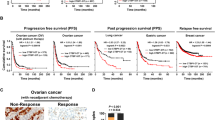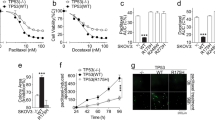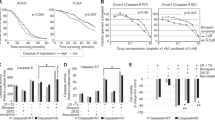Abstract
Activation of p53 by cellular stress may lead to either cell cycle arrest or apoptotic cell death. Restrictions in a cell's ability to halt the cell cycle might, in turn, cause mitotic catastrophe, a delayed type of cell death with distinct morphological features. Here, we have investigated the contribution of p53 and caspase-2 to apoptotic cell death and mitotic catastrophe in cisplatin-treated ovarian carcinoma cell lines. We report that both functional p53 and caspase-2 were required for the apoptotic response, which was preceded by translocation of nuclear caspase-2 to the cytoplasm. In the absence of functional p53, cisplatin treatment resulted in caspase-2-independent mitotic catastrophe followed by necrosis. In these cells, apoptotic functions could be restored by transient expression of wt p53. Hence, p53 appeared to act as a switch between apoptosis and mitotic catastrophe followed by necrosis-like lysis in this experimental model. Further, we show that inhibition of Chk2, and/or 14-3-3σ deficiency, sensitized cells to undergo mitotic catastrophe upon treatment with DNA-damaging agents. However, apoptotic cell death seemed to be the final outcome of this process. Thus, we hypothesize that the final mode of cell death triggered by DNA damage in ovarian carcinoma cells is determined by the profile of proteins involved in the regulation of the cell cycle, such as p53- and Chk2-related proteins.
Similar content being viewed by others
Log in or create a free account to read this content
Gain free access to this article, as well as selected content from this journal and more on nature.com
or
Abbreviations
- Chk1–2:
-
checkpoint kinase
- cisplatin:
-
cis-diaminedichloro-platinum(II)
- DBH:
-
debromohymenialdisine
- 5-FU:
-
5-fluorouracil
- FACS:
-
fluorescence-activated cell sorting
- fmk:
-
fluoromethyl ketone
- PI:
-
propidium iodide
References
Sancar A, Lindsey-Boltz LA, Unsal-Kacmaz K, Linn S . Molecular mechanisms of mammalian DNA repair and the DNA damage checkpoints. Annu Rev Biochem 2004; 73: 39–85.
Shieh SY, Ikeda M, Taya Y, Prives C . DNA damage-induced phosphorylation of p53 alleviates inhibition by MDM2. Cell 1997; 91: 325–334.
Vogelstein B, Lane D, Levine AJ . Surfing the p53 network. Nature 2000; 408: 307–310.
Bunz F, Dutriaux A, Lengauer C, Waldman T, Zhou S, Brown JP et al. Requirement for p53 and p21 to sustain G2 arrest after DNA damage. Science 1998; 282: 1497–1501.
Chan TA, Hermeking H, Lengauer C, Kinzler KW, Vogelstein B . 14-3-3Sigma is required to prevent mitotic catastrophe after DNA damage. Nature 1999; 401: 616–620.
Miyashita T, Reed JC . Tumor suppressor p53 is a direct transcriptional activator of the human bax gene. Cell 1995; 80: 293–299.
Nakano K, Vousden KH . PUMA, a novel proapoptotic gene, is induced by p53. Mol Cell 2001; 7: 683–694.
Tinel A, Janssens S, Lippens S, Cuenin S, Logette E, Jaccard B et al. Autoproteolysis of PIDD marks the bifurcation between pro-death caspase-2 and pro-survival NF-kappaB pathway. EMBO J 2007; 26: 197–208.
Lin Y, Ma W, Benchimol S . Pidd, a new death-domain-containing protein, is induced by p53 and promotes apoptosis. Nat Genet 2000; 26: 122–127.
Tinel A, Tschopp J . The PIDDosome, a protein complex implicated in activation of caspase-2 in response to genotoxic stress. Science 2004; 304: 843–846.
Guo Y, Srinivasula SM, Druilhe A, Fernandes-Alnemri T, Alnemri ES . Caspase-2 induces apoptosis by releasing proapoptotic proteins from mitochondria. J Biol Chem 2002; 277: 13430–13437.
Lassus P, Opitz-Araya X, Lazebnik Y . Requirement for caspase-2 in stress-induced apoptosis before mitochondrial permeabilization. Science 2002; 297: 1352–1354.
Robertson JD, Enoksson M, Suomela M, Zhivotovsky B, Orrenius S . Caspase-2 acts upstream of mitochondria to promote cytochrome c release during etoposide-induced apoptosis. J Biol Chem 2002; 277: 29803–29809.
Vakifahmetoglu H, Olsson M, Orrenius S, Zhivotovsky B . Functional connection between p53 and caspase-2 is essential for apoptosis induced by DNA damage. Oncogene 2006; 25: 5683–5692.
Jonathan EC, Bernhard EJ, McKenna WG . How does radiation kill cells? Curr Opin Chem Biol 1999; 3: 77–83.
Heald R, McLoughlin M, McKeon F . Human wee1 maintains mitotic timing by protecting the nucleus from cytoplasmically activated Cdc2 kinase. Cell 1993; 74: 463–474.
Castedo M, Perfettini JL, Roumier T, Valent A, Raslova H, Yakushijin K et al. Mitotic catastrophe constitutes a special case of apoptosis whose suppression entails aneuploidy. Oncogene 2004; 23: 4362–4370.
Roninson IB, Broude EV, Chang BD . If not apoptosis, then what? Treatment-induced senescence and mitotic catastrophe in tumor cells. Drug Resist Updat 2001; 4: 303–313.
Lock RB, Stribinskiene L . Dual modes of death induced by etoposide in human epithelial tumor cells allow Bcl-2 to inhibit apoptosis without affecting clonogenic survival. Cancer Res 1996; 56: 4006–4012.
Eltabbakh GH, Awtrey CS . Current treatment for ovarian cancer. Expert Opin Pharmacother 2001; 2: 109–124.
Bunz F, Hwang PM, Torrance C, Waldman T, Zhang Y, Dillehay L et al. Disruption of p53 in human cancer cells alters the responses to therapeutic agents. J Clin Invest 1999; 104: 263–269.
Paroni G, Henderson C, Schneider C, Brancolini C . Caspase-2 can trigger cytochrome C release and apoptosis from the nucleus. J Biol Chem 2002; 277: 15147–15161.
Hamroun D, Kato S, Ishioka C, Claustres M, Beroud C, Soussi T . The UMD TP53 database and website: update and revisions. Hum Mutat 2006; 27: 14–20.
Castedo M, Perfettini JL, Roumier T, Yakushijin K, Horne D, Medema R et al. The cell cycle checkpoint kinase Chk2 is a negative regulator of mitotic catastrophe. Oncogene 2004; 23: 4353–4361.
Mansilla S, Priebe W, Portugal J . Mitotic catastrophe results in cell death by caspase-dependent and caspase-independent mechanisms. Cell Cycle 2006; 5: 53–60.
Colussi PA, Harvey NL, Kumar S . Prodomain-dependent nuclear localization of the caspase-2 (Nedd2) precursor. A novel function for a caspase prodomain. J Biol Chem 1998; 273: 24535–24542.
Mancini M, Machamer CE, Roy S, Nicholson DW, Thornberry NA, Casciola-Rosen LA et al. Caspase-2 is localized at the Golgi complex and cleaves golgin-160 during apoptosis. J Cell Biol 2000; 149: 603–612.
Ren J, Shi M, Liu R, Yang QH, Johnson T, Skarnes WC et al. The Birc6 (Bruce) gene regulates p53 and the mitochondrial pathway of apoptosis and is essential for mouse embryonic development. Proc Natl Acad Sci USA 2005; 102: 565–570.
van Loo G, Saelens X, Matthijssens F, Schotte P, Beyaert R, Declercq W et al. Caspases are not localized in mitochondria during life or death. Cell Death Differ 2002; 9: 1207–1211.
Zhivotovsky B, Samali A, Gahm A, Orrenius S . Caspases: their intracellular localization and translocation during apoptosis. Cell Death Differ 1999; 6: 644–651.
De Feudis P, Debernardis D, Beccaglia P, Valenti M, Graniela Sire E, Arzani D et al. DDP-induced cytotoxicity is not influenced by p53 in nine human ovarian cancer cell lines with different p53 status. Br J Cancer 1997; 76: 474–479.
Debernardis D, Sire EG, De Feudis P, Vikhanskaya F, Valenti M, Russo P et al. p53 status does not affect sensitivity of human ovarian cancer cell lines to paclitaxel. Cancer Res 1997; 57: 870–874.
Lamkanfi M, D'Hondt K, Vande Walle L, van Gurp M, Denecker G, Demeulemeester J et al. A novel caspase-2 complex containing TRAF2 and RIP1. J Biol Chem 2005; 280: 6923–6932.
Chan TA, Hwang PM, Hermeking H, Kinzler KW, Vogelstein B . Cooperative effects of genes controlling the G(2)/M checkpoint. Genes Dev 2000; 14: 1584–1588.
Meek DW . The role of p53 in the response to mitotic spindle damage. Pathol Biol (Paris) 2000; 48: 246–254.
Tao W, South VJ, Zhang Y, Davide JP, Farrell L, Kohl NE et al. Induction of apoptosis by an inhibitor of the mitotic kinesin KSP requires both activation of the spindle assembly checkpoint and mitotic slippage. Cancer Cell 2005; 8: 49–59.
Chen JG, Yang CP, Cammer M, Horwitz SB . Gene expression and mitotic exit induced by microtubule-stabilizing drugs. Cancer Res 2003; 63: 7891–7899.
Castedo M, Coquelle A, Vivet S, Vitale I, Kauffmann A, Dessen P et al. Apoptosis regulation in tetraploid cancer cells. EMBO J 2006; 25: 2584–2595.
Demarcq C, Bunch RT, Creswell D, Eastman A . The role of cell cycle progression in cisplatin-induced apoptosis in Chinese hamster ovary cells. Cell Growth Differ 1994; 5: 983–993.
Jordan MA, Wendell K, Gardiner S, Derry WB, Copp H, Wilson L . Mitotic block induced in HeLa cells by low concentrations of paclitaxel (Taxol) results in abnormal mitotic exit and apoptotic cell death. Cancer Res 1996; 56: 816–825.
Waldman T, Lengauer C, Kinzler KW, Vogelstein B . Uncoupling of S phase and mitosis induced by anticancer agents in cells lacking p21. Nature 1996; 381: 713–716.
Nitta M, Kobayashi O, Honda S, Hirota T, Kuninaka S, Marumoto T et al. Spindle checkpoint function is required for mitotic catastrophe induced by DNA-damaging agents. Oncogene 2004; 23: 6548–6558.
Chu K, Teele N, Dewey MW, Albright N, Dewey WC . Computerized video time lapse study of cell cycle delay and arrest, mitotic catastrophe, apoptosis and clonogenic survival in irradiated 14-3-3sigma and CDKN1A (p21) knockout cell lines. Radiat Res 2004; 162: 270–286.
Acknowledgements
We thank Dr. Bert Vogelstein (The Johns Hopkins School of Medicine, Baltimore, USA) for providing 14-3-3σ−/− HCT116 cells and plasmid-encoding wild-type p53 and Margareta Sandström for technical assistance. This study was supported by grants from the Swedish Science Foundation (K2006-31X-02471-39-3 and 2006-24035-41265-48), Swedish (06-0279) and Stockholm (061491) Cancer Societies and the EC-FP-6 (Oncodeath and Chemores) and EC-FP-7 (APO-SYS).
Author information
Authors and Affiliations
Corresponding author
Additional information
Edited by A Villunger
Supplementary Information accompanies the paper on Cell Death and Differentiation website (http://www.nature.com/cdd)
Supplementary information
Rights and permissions
About this article
Cite this article
Vakifahmetoglu, H., Olsson, M., Tamm, C. et al. DNA damage induces two distinct modes of cell death in ovarian carcinomas. Cell Death Differ 15, 555–566 (2008). https://doi.org/10.1038/sj.cdd.4402286
Received:
Revised:
Accepted:
Published:
Issue date:
DOI: https://doi.org/10.1038/sj.cdd.4402286
Keywords
This article is cited by
-
Benzimidazole carbamate induces cytotoxicity in breast cancer cells via two distinct cell death mechanisms
Cell Death Discovery (2023)
-
Hornerin mediates phosphorylation of the polo-box domain in Plk1 by Chk1 to induce death in mitosis
Cell Death & Differentiation (2023)
-
Targeting of tubulin polymerization and induction of mitotic blockage by Methyl 2-(5-fluoro-2-hydroxyphenyl)-1H-benzo[d]imidazole-5-carboxylate (MBIC) in human cervical cancer HeLa cell
Journal of Experimental & Clinical Cancer Research (2016)
-
E1A enhances cellular sensitivity to DNA-damage-induced apoptosis through PIDD-dependent caspase-2 activation
Cell Death Discovery (2016)
-
Promotion of mitotic catastrophe via activation of PTEN by paclitaxel with supplement of mulberry water extract in bladder cancer cells
Scientific Reports (2016)



